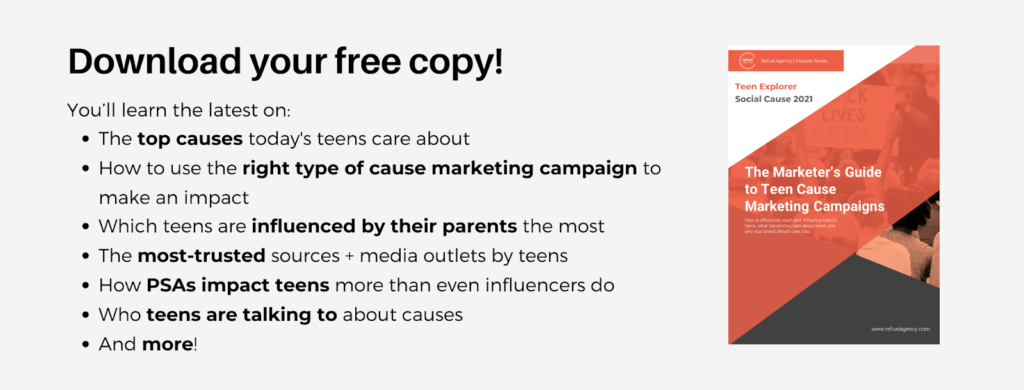Tis the season… for holiday cause campaigns! Nonprofits and their corporate partners come together to tap into the generosity of holiday shoppers by launching creative cause campaigns. Holiday shoppers want to do good while making their list and checking it twice.
So how can you step into the season and create meaningful holiday cause marketing campaigns that make a difference and motivate your audience to join in? We’ve been running cause marketing campaigns for over 30 years and we have some tips.

What is an example of a successful cause marketing campaign?
In 2016, Uber launched a campaign called UberGIVING, where Uber users could swipe “Giving” to request a car to pick up donations and deliver them to local charity partners (like Save the Children in the UK).
A successful cause marketing campaign leverages your existing product, service, or expertise to integrate with and amplify your partner cause. Uber leveraged its fleet of drivers all over the world to provide a way for people to donate their unused items during the holiday season.
And how did the campaign do?
- Reached 46 countries across Europe
- Donations filled 10 shipping containers
- 232 partner drivers took part
- 2,828 collections were made
- 33,572 unique requests from customers were made
- 5.6m social impressions were generated with no media spend and no paid influencers
1. Evaluate your value proposition
The first step to creating a winning holiday cause marketing campaign this holiday season is to evaluate what your brand has to offer that is of value to a cause partner. Uber provided a great example—Uber was able to leverage its existing service (ridesharing) to serve the cause partner. Additionally, it was able to do it all in a way that made Uber users feel actively involved and invested. The result? A win for the cause, and a win for the brand.
So, what product or service is already aligned with a cause you would like to give back to?
Read next: 5 Examples of Brands That Got Cause Marketing Right
2. Make participating accessible and exciting
The second step to creating a holiday cause campaign that consumers can be excited about is to make it easy and accessible for them to participate. If the barrier to entry is too steep, your customers will lose interest and your campaign will flop.
So the key is removing any and all friction that may be in the way. For example, Amazon has used their voice assistant, Alexa, to help raise money for Toys for Tots. They encouraged Alexa users to simply say, “Alexa, donate to Toys for Tots,” and Alexa presents a selected toy to donate.
Provide everything customers could possibly need to participate. Create fun graphics your customers will want to share on social media, set up a donation tracker on your website so your audience can be motivated by the donations accumulating, shout out donors names—and the list goes on.
Read next: What Is Cause Marketing, and How Does it Drive Brand Loyalty?
3. Use an omnichannel approach to amplify your campaign results
Make sure that your campaigns are reaching your target audiences by using an omnichannel approach guaranteed to reach them.
An omnichannel marketing strategy places the customer at the center, ensuring a unified shopping experience at every touch point. While a multichannel approach views more marketing channels as more ways to reach the customer, the omnichannel approach views more channels as a way to remove friction and increase consistency—which in turn, builds brand loyalty.
Read next: What Is An Omnichannel Marketing Strategy, and How Can It Help You Drive Sales?
4. Participate in Giving Tuesday
It’s a post-pandemic world, and brand purpose matters in a way it never has before. Studies show that 56% of Americans will stop buying from brands they believe to be unethical, and 91% of people feel that their own actions, such as donating or buying, can make a difference. Consumers view their spending habits as an extension of their identity and their values.
Giving Tuesday is a “global generosity movement unleashing the power of people and organizations to transform their communities and the world”. It’s a day that encourages people to do good—and many brands take advantage of this day to meet their corporate social responsibility objectives, further social change, and give back to their communities.
To make a meaningful impact on your customers this holiday season, align your brand with the causes your target audience cares about. Giving Tuesday is a good way to do this. You could even get your customers to join in on the giving by running a match campaign, or providing incentives for giving.
Read next: How Brands Can Give Back to Their Customers This Giving Tuesday [Resources Included]
Interested in cause marketing for teens? Find out everything you need to know about creating a cause marketing campaign for teens by downloading our free ebook! We’re here to help you build cause marketing campaigns that make an impact.




![Read more about the article How Brands Can Give Back to Their Customers This Giving Tuesday [Resources Included!]](https://www.refuelagency.com/wp-content/uploads/2020/11/iStock-1064841594-e1604617499760-768x614.jpg)